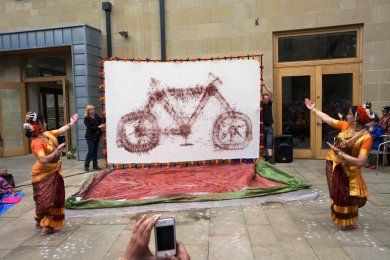
|   |

|   |
Bicycle with barefoot - Dr Nima Poovaya-Smith e-mail: umimistry@alchemyanew.com September 17, 2014 Kuchipudi is an ancient classical Indian dance form from the Southern state of Andhra Pradesh, known for its intricate footwork and subtlety of emoting through a range of facial expressions. The artistic director of Halifax-based Annapurna Dance, the irrepressible and imaginative Shantha Rao had conceived an unusual performance as part of the Tour de France Cultural Festival. Two Kuchipudi dancers would literalIy, through rhythmic dance movements sketch out an image of a bicycle onto a canvas placed over powdered paint.  I wondered apprehensively, if this would end up being gimmicky. I could not have been more wrong. In the packed Viaduct Theatre at Dean Clough, Halifax, a charged atmosphere was being created through the burning of incense, the lighting of lamps and the hypnotic rhythms created by percussion instruments used for Carnatic music such as the ghatam and mridangam. Classical Indian dance, which has a close interrelationship with sculpture, is always a compelling visual spectacle and this one was especially so. The coral, gold and violet of the dancers’ costumes, their flowers and jewellery were arresting in their own right. Their dancing certainly delighted the audience and when they began to dance on the canvas, with remarkably precise footwork, excitement was at fever pitch. When the canvas was raised to reveal the powdery contours of a bicycle there was a unanimous gasp of wonderment from the audience. I wondered how the Peloton, a solid mass of muscle and bone, would react if these glittering, ethereal creatures had suddenly appeared before them as they pedalled furiously through Yorkshire. This performance seemed like an invocation, a direct appeal to the deities, for an auspicious Tour de France. Its particular power was derived from the fact that the dancers were actually referencing a rare aspect of Kuchipudi, called the simhanandini, where the outline of a lion (simha) is traced by the dancers as a plea to the Mother Goddess to conquer the forces of evil and illuminate darkness. However, the performance, consciously or unconsciously, also taps into other Indian visual traditions. The rangoli or floor painting is a domestic art practised all over India. Geometric patterns drawn from sacred symbology, as well as stylised images from the Hindu pantheon of gods, are created using a variety of media from rice flour to coloured sand to rose petals. Usually traced at the entrance to a house, they are meant to be sacred welcoming spaces for the gods. The bicycle created in front of our eyes certainly fitted into the tradition of the ‘painted prayer’ as rangolis have been described. Another visual vocabulary seemingly being referenced is a very local one. The village of Kuchipudi, where it is popularly believed this dance form originates, is situated near the historic towns of Machilipatnam and Kalahasti, famed for their kalamkaris. These are dye-painted cloths, where a pen-like tool (the kalam) is used to draw figurative, vegetal and abstract outlines on the cloth. I would not be surprised if the simhanandinis were not influenced by this neighbouring tradition, since there is a close resemblance between the kalamkari lion and the Kuchipudi lion. The dancers were Abhinandana MK, Kopal Vedam and Sarvani Yadavalli. The musicians were Bangalore Prakash (mridangam), Kamal Bir Sing (violin), Ramya Tangirala (vocals), with narration by Navya Rattehalli. Shantha Rao has managed to compress the ancient and the sacred, dance and the visual arts, and present it in a manner that makes it utterly relevant to a 21st century Yorkshire revelling in the fact that it had hosted the Grand Depart for one of Europe’s most iconic sporting events. ‘Bicycle with Barefoot’ was part of the Yorkshire Festival 2014 programme. Yorkshire Festival 2014 is the first Cultural Festival to accompany a Tour de France in its 111 year history. Dr. Nima Poovaya-Smith is Director, Alchemy in Leeds. |